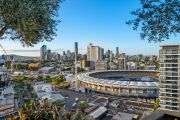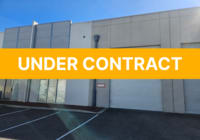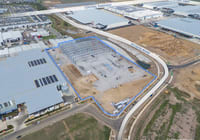
Warehouses, build-to-rent work best for Rich Lister Tarascio family
Build-to-rent housing and logistics estates are proving the most viable real estate ventures for Melbourne-based Salta Properties, owned by the Rich Lister Tarascio family, which is going slow on build-to-sell projects until market conditions improve.
On those two fronts, Salta – it is led by Sam Tarascio, whose Rich Lister father bears the same name – is forging ahead, completing a pilot build-to-rent project in inner-city North Fitzroy and now preparing to launch its first major facility, a 474-unit, $500 million development in Richmond.

Salta has also pressed “go” on the next phase of an industrial estate it controls in Cranbourne West in Melbourne’s south-east, not far from the group’s long-standing effort to create an intermodal terminal linking rail and road transport.
“We see built-to-rent as a really important solution and part of the overall housing mix,” Tarascio told The Australian Financial Review this week.
“It’s a sector where we can see the merits of continuing to develop. It’s at a very early stage, and it’s only going to continue to grow over time as more capital comes into that sector.”
As Salta’s development pipeline swings further into the rental model, it has accumulated sites that could house as many as 2000 apartments with an end value of around $1.5 billion.
In the past, the Tarascio family platform has delivered office space as well as build-to-sell apartments, but such projects are just not viable in the current market, Tarascio said.
“For build-to-sell residential, the [price] gap between existing stock and the cost of producing new stock is such that it’s very hard to get a new build-to-sell project to stack up until we either see productivity improving or costs coming down or prices rising, or more likely a combination of all three,” he said.

At the other end of the development spectrum, Salta is putting to the market 12 lots at its industrial estate on the Western Port Highway, each of them at least 6375 square metres, When fully developed, that part of the estate could be worth as much as $800 million.
The launch follows Salta’s sale last year of around 50 per cent of the site to ESR and Frasers Property Industrial, in a joint-venture deal for a $200 million.
Development of the estate – which it’s dubbed Industrial Quarter or iQ and which sits in the city’s south-east industrial zone – chimes with Salta’s investment into an emerging intermodal terminal and surrounding estate nearby in Dandenong South.
“Combined with our intermodal rail terminal, which will reshape freight efficiency across the south-east and reinforce the strategic advantage of our precincts for large-scale industrial users, the corridor will be solidified as the mecca for industrial operations and industrial land value,” Tarascio said.
More broadly, Tarascio is taking a diplomatic line on the hot-button topic for Victoria’s property sector: the state budget handed down this month by the Allan Labor government underscored the reliance of the state’s treasury on real estate sector, raising the highest proportion of any state from property taxes.
Investors, especially from offshore, are already turning away from the state’s off-the-plan apartment sector in response to high levels of taxation, said Tarascio, who urged the state government to strike the right balance between “collection of tax and not overburdening the sector”.
“We feel as a sector that some of that [taxation] has gone too far, and it’s potentially causing detriment to the sector. With the right dialogue with government, we can get those settings right.
“Foreign capital is viewing Victoria as a less desirable place to invest because of some of additional imposts on foreign investors.
“It’s another opportunity for the government to think about what they are trying to achieve as a result of the foreign levies. Is it purely about earning revenue – which isn’t going to be there if the foreigners aren’t investing – or are we trying to figure out the best way to fund the property infrastructure needed for this state?”











